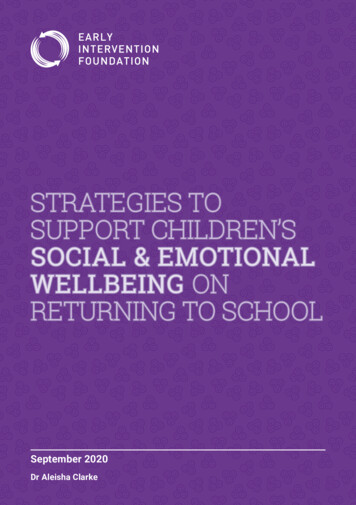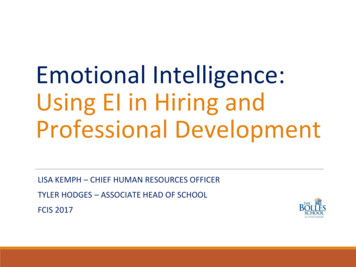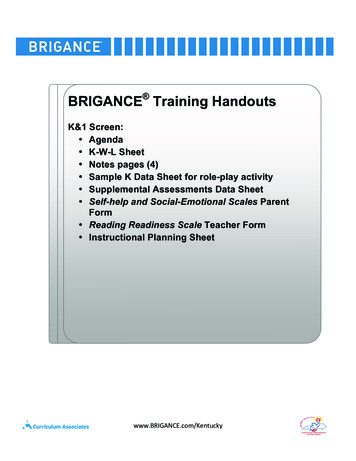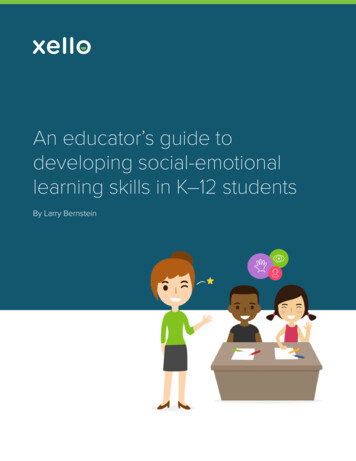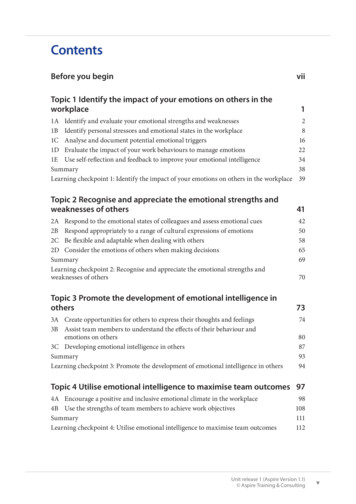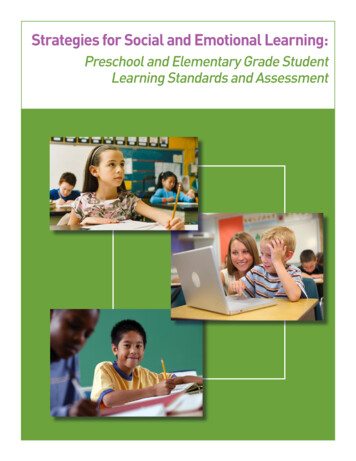
Transcription
Strategies for Social and Emotional Learning:Preschool and Elementary Grade StudentLearning Standards and Assessment
Strategies for Social and Emotional Learning:Preschool and Elementary Grade Student Learning Standards and AssessmentOverview4. Explain how to effectively use SEL assessmenttools to monitor students’ progress towardachieving social and emotional development goalsSocial and Emotional Learning (SEL) is an essentialcomponent of keeping children and youth safe andhealthy. SEL programming delivered in schools helpsstudents succeed in school and in life.The Importance of SELSchools are focusing more on developing SELprogramming for students as research highlightsthe positive relationship of SEL to academic success.Research demonstrates that schools should offer safeand supportive environments to promote the “soft”or “noncognitive” skills that are critical for futuresuccess in higher education and business.2,3,4 Suchsocial and emotional skills include a strong workethic, teamwork, self-efficacy, and confidence. Manyeducators promote accountability in schools forproviding the safe and supportive environments —including implementing SEL programs—necessary toachieve these outcomes.5This brief provides Safe Schools/Healthy Students(SS/HS) project directors (PDs) with informationand strategies to implement and assess SEL in theirschools and districts. The purpose of this brief is to:1. Describe SEL student learning standards2. Introduce a set of universal teacher-ratedassessment tools that can be used to measureSEL with preschool through elementary-schoolchildren3. Provide guidance on implementing andassessing SEL in school settingsWhat is Social and Emotional Learning?The Collaborative for Academic, Social, and Emotional Learning (CASEL) describesSEL as the process of developing the following five sets of core competencies in thecontext of safe, caring, well-managed, academically rigorous, and engaging learningenvironments: Self-awareness—being able to accurately assess one’s feelings, interests, values,and strengths; maintaining a well-grounded sense of self-confidence Self-management—being able to regulate one’s emotions to handle stress,control impulses, and persevere in overcoming obstacles; setting and monitoringprogress toward personal and academic goals; expressing emotions effectively Social awareness—being able to take the perspective of and empathize withothers; recognizing and appreciating individual and group similarities anddifferences; recognizing and using family, school, and community resources Relationship skills—being able to establish and maintain healthy and rewardingrelationships based on cooperation; resisting inappropriate social pressure;preventing, managing, and resolving interpersonal conflict; seeking help whenneeded Responsible decision-making—being able to make decisions based onconsideration of reason, ethical standards, safety concerns, social norms, respectfor self and others, and likely consequences of various actions; applying decisionmaking skills to academic and social situations; contributing to the well-being ofone’s school and community.11
Strategies for Social and Emotional Learning:Preschool and Elementary Grade Student Learning Standards and AssessmentOne recent analysis of SEL research examinedthe effect of SEL programs across diverse studentoutcomes. The analysis reviewed 213 studiesthat involved over 270,000 students from urban,suburban, and rural schools. The data demonstratedthat social and emotional skills could be taught tostudents. The results also showed that students whoreceived instruction in SEL, when compared withtheir peers, demonstrated: Enhanced skills, attitudes, and positive socialbehaviors Fewer conduct problems Lower levels of emotional distress Significantly improved academic performance,scoring an average of 11 percentile pointshigher on standardized tests6emerge. Most notably, it appears that the preschoolenvironment is far ahead of the K–12 educationalsystem in establishing comprehensive standardsfor children’s social and emotional development.The scan conducted by CASEL of preschool learningstandards found that 49 states and the District ofColumbia currently have standards for children’ssocial and emotional development.Additionally, some states also provide guidelines forpreschool educators about how to support social andemotional development, and/or how educators canmonitor progress toward standards. Below are linksto examples of standards in five states:Educators who work with preschool-age childrenhave long understood the importance of addressingsocial and emotional development.7,8 In fact, researchshows that “one of the most consistent findings inthe early childhood literature is that an emotionallywarm and positive approach in learning situationsleads to constructive behavior in children.”8 California Preschool Learning Foundations Idaho Early Learning eGuidelines (Domain 3:Social and Emotional Learning) Pennsylvania Learning Standards for EarlyChildhood (Pre-Kindergarten) Revised Texas Prekindergarten Guidelines Washington State Early Learning andDevelopment BenchmarksPreschool, Kindergarten, and Early ElementaryEducation Universal SEL StandardsFor older children, improving the emotional qualityof classroom interactions positively predicts growthin reading and math achievement from first throughfifth grades.9 While starting early is important, SELacross all years of schooling can enhance students’social and emotional behaviors that will impact theirsuccess in school and beyond.3Some states have developed SEL standards forpreschool, kindergarten, and early elementary gradesas part of their efforts to integrate these strategiesinto the early years of education. Below are examplesof standards in two states:SEL Student LearningStandardsRigorous standards describing what students shouldknow and be able to do are essential for instructionin any subject area, especially core academicsubjects (English Language Arts, math, science,and social studies) and SEL. The Collaborative forAcademic, Social, and Emotional Learning (CASEL) isconducting a review of SEL standards from preschoolto high school for all 50 states and the 6 territories. Idaho Early Learning eGuidelines (First,Second and Third Grades, Domain 3: Socialand Emotional Learning) Pennsylvania Early Learning Standardsthrough Second GradeK-12 SEL Standards—the Illinois ModelAt the K-12 level, many states integrate at least afew elements of SEL into standards for curriculumareas such as language arts, social studies, andhealth. Illinois is the only state that has developeda comprehensive set of free-standing K-12 SELstandards with its Illinois Learning Standard forSocial/Emotional Learning.Preliminary Findings from the State Scan ofPreschool SEL StandardsA broadly representative group—teachers, schooladministrators, student support staff, humanservices professionals, and parents, all with expertiseThe CASEL state scan of SEL standards is still inprogress, but a number of findings have begun to2
Strategies for Social and Emotional Learning:Preschool and Elementary Grade Student Learning Standards and Assessmentin child development and learning, curriculumdesign, and instruction—developed these SELgoals, standards, benchmarks, and performancedescriptors.A number of other states have also developed a setof free-standing K-12 standards that address oneof more important aspects of social and emotionaldevelopment:The Illinois standards are focused on three overarching goals: Goal 1: Develop self-awareness and selfmanagement skills to achieve school and lifesuccess.»» Learning standard A: Identify and manageone’s emotions and behavior.»» Learning standard B: Recognize personalqualities and external supports.»» Learning standard C: Demonstrate skillsrelated to achieving personal and academicgoals. Goal 2: Use social-awareness and interpersonalskills to establish and maintain positiverelationships.Kansas Standards for Communication Oklahoma Rubric Describing School Climate Pennsylvania School Climate Standards (Draft) Pennsylvania Interpersonal Skills Standards(Draft) Tennessee Service-Learning Standards Vermont’s Vital Results Standards withinits Framework of Standards and LearningOpportunities Washington Communication LearningStandardsMeasuring Progress in Adopting SEL StandardsAs research emphasizing the importance of SEL foracademic progress becomes more widely known,and standards for what social and emotionalcompetencies students should exhibit become moreprevalent, measuring students’ progress towardstandards becomes a vital task.»» Learning standard A: Recognize thefeelings and perspectives of others.»» Learning standard B: Recognize individualand group similarities and differences.»» Learning standard C: Use communicationand social skills to interact effectively withothers.As with standards adoption, movement toward thewidespread use of reliable and valid measures of socialand emotional competencies is much more advancedin the preschool domain than it is in K–12 education.Quality improvement and accountability initiativesin programs such as Head Start, state-funded prekindergarten, early childhood special education, andchild care have led to a variety of direct (administeredto children) and indirect (administered to adults whoknow the children) assessments.»» Learning standard D: Demonstrate anability to prevent, manage, and resolveinterpersonal conflicts in constructiveways. Goal 3: Demonstrate decision-making skillsand responsible behaviors in personal, school,and community contexts.The National Research Council’s review ofearly childhood assessment indicates that anymeasurement of children should be guided by twoprinciples: (1) purposefulness, in which the measure isdesigned or selected based on how it will be used (suchas to evaluate program outcomes or to assess a child’sfunctional capacities); and (2) “systematicity,” in whichassessments are only given in the context of care andeducational supports that can constructively use thedata to promote children’s optimal development.10»» Learning standard A: Consider ethical,safety, and societal factors in makingdecisions.»» Learning standard B: Apply decisionmaking skills to deal responsibly with dailyacademic and social situations.»» Learning standard C: Contribute to thewell-being of one’s school and community.3
Strategies for Social and Emotional Learning:Preschool and Elementary Grade Student Learning Standards and AssessmentTeacher Behavior Rating Scales Of Students’Social-Emotional CompetenceWithin the early childhood arena, several compendia ofearly childhood measures, including SEL assessments,have already been developed, including the following: Early Childhood Measures Profiles Quality in early childhood care and educationsettings: A compendium of measures(2ndedition) Resources for Measuring Services andOutcomes in Head Start Programs ServingInfants and Toddlers. The Compendium of Screening Tools for EarlyChildhood Social-emotional Development.One advantage of teacher rating scales is thatteachers are good informants about their studentsbecause they are familiar with children’s behavior inan important environment (school), and teachersare generally skilled raters because they know a largenumber of children with whom to compare any onestudent’s skills or behaviors. Furthermore, teacherSEL assessments that are in line with state SELstandards will enhance teachers’ capacities to observeand enhance students’ skills and dispositions in thesocial-emotional domain.For elementary age students, fewer suchcompilations of measures exist, but include: The SEL Assessment Rating ApproachThe Work Group identified teacher rating scalesmeeting the following criteria:Scales from Student Questionnaire, ChildDevelopment Project for Elementary SchoolStudents (grades 3–6). Individual Protective Factors Index. Compendium of Social-emotional Learningand Associated Assessment Measures.1. The assessment should measure SEL constructs.It should have some documentation (e.g., amanual) that contains a description of themeasure, the constructs assessed, and anyassignment of items to scales.SEL Assessment2. The assessment should be appropriate for thegrades pre-k through five.As SEL standards become more widely adopted, it isincreasingly important to develop tools to measureSEL. In order to identify and develop measures ofSEL for practitioners, in 2008, CASEL convened thePreschool to Elementary School Social and EmotionalLearning Assessment Work Group to consider howbest to assess SEL among preschool through grade5 children, including identifying several qualityteacher-rating measures, for assessing students’ SEL.3. The assessment should be able to be administeredwithin a reasonable time frame (e.g., 10–20minutes). The reasonableness of administrationtime depends on whether all children in aschool or classroom, or only select children, areassessed. (Collecting ratings for all students willproduce as complete a profile as possible of aschool’s SEL competencies, but time constraintsmay indicate that only rating a random sampleof students in each classroom is possible.)Recommendations for assessments to review werebased on the Work Group members’ experience andknowledge of available assessments and a broadsearch of the literature. In selecting assessments, theWork Group sought assessments that:4. The assessment should have adequatereliability and validity.5. There should be standards data or benchmarksavailable to help interpret results. (Althoughnot all reviewed measures had norms orbenchmarks, their presence was noted.)1. Addressed most of the five SEL corecompetencies6. Where possible, the measure should beavailable for electronic administration andscoring, which is both faster and less expensivethan paper-based administration and handscoring.2. Were appropriate for the pre-kindergartenthrough fifth-grade student population3. Had an established track record4
Strategies for Social and Emotional Learning:Preschool and Elementary Grade Student Learning Standards and AssessmentAdditionally, the Work Group noted the cost of theassessment per student, manual, assessment form,and other services.Schools may decide to select other assessments ifthey feel that a particular measure is appropriate fortheir environment and students.Table 1 lists the reviewed assessments, thegrades they cover, and the constructs that theyassess. Schools can benefit from using any of theassessments reviewed. All of the assessments havethe following strengths:Implementing SEL in YourSchool or DistrictCollecting and Reviewing Data1. All of the teacher versions were appropriate forstudents in grades pre-kindergarten througheight.It is imperative for administrators, teachers, and staffto routinely collect and review data about the socialand emotional competencies of their students andthen use those data to inform decisions about howto increase successful outcomes for their particularpopulation.2. They can be administered by teachers, schoolpersonnel, and mental health professionals.3. They can be completed in 10-20 minutes perstudent.The basic process in using data about students’social-emotional competencies is to:4. They provide standards or benchmarks thatcan be used to compare individual studentscores.1. Understand the facts2. Share the facts with program implementersand key stakeholders (e.g., schooladministrators)5. According to their manuals, they haveestablished reliability and validity.6. They state that they can be used for multiplepurposes, including student assessment,screening, and evaluating program effects.3. Act on the factsUsing one of the teacher-rating tools identifiedin this brief, the school team can systematicallyTable 1. Summary of Grades and Constructs Assessed for Teacher Ratings of Students’ SEL CompetenciesBehavioral and EmotionalRating Scale (BERS)Devereux Early ChildhoodAssessment (DECA)Devereux Student StrengthsAssessment (DESSA)Social-Emotional Assets andResilience Scale (SEARS)Social Skills ImprovementSystem ourthThirdSecondConstructs AssessedFirstKindergartenGrade LevelPreschoolAssessment Name
Strategies for Social and Emotional Learning:Preschool and Elementary Grade Student Learning Standards and Assessmentmeasure and track their students’ social-emotionalcompetencies at the classroom, grade, school, anddistrict levels. For each survey scale, the team shouldlook at the overall results, as well as results forimportant subgroups of students.grades, disciplinary referrals, and achievement,can help you understand the big pictureDeveloping an SEL Action PlanThe team should then identify and prioritize areasfor improvement that are grounded in the dataand consistent with the vision for SEL. Teams maywant to capitalize upon existing resources, or maychoose to start fresh. Solutions should be systematicand meaningful (not “quick fixes”), be theoreticallysound, and use evidence-based approaches that havebeen proven in real-world settings.When examining SEL data you can expand yourunderstanding of results by doing the following: Look for connections across scales for differentgroups of students. For example, studentswho are English language learners or studentswith disabilities may have strikingly differentprofiles of social-emotional competencies thanother students.Two CASEL publications are designed to assist inthe selection of programs or strategies and can helpinform your action plan:Look at trends. Student competencies mayincrease, decrease, or stay the same overtime. Examining trends helps focus ongrowing issues and make adjustments in SELprogramming to address these issuesLook at the social-emotional competencedata in conjunction with other school data.Reviewing other data, such as attendance, Sustainable Schoolwide Social and EmotionalLearning (SEL): Implementation Guide andToolkit Safe and Sound: An Educational Leader's Guideto Evidence-based SEL ProgramsOther SEL Assessment MethodsIn addition to teacher behavior rating scales of students’ social-emotionalcompetence, there are other relevant SEL assessment methods:1. Student self-report. Although there are concerns with the validity and reliabilityof this assessment method especially for this grade range, many experts believe itis important to acknowledge the students’ perspective in the assessment of theirSEL competencies starting in third grade.2. Third-party Observational Methods and Performance-based Assessments.These methods are valid, but require trained observers and administrators andconsiderably more time to administer than teacher ratings or self-report. As such,their cost is relatively higher. However, one observational measure, the ClassroomAssessment Scoring System (CLASS) is notable in the context of SEL assessment.The CLASS is a proven observational instrument assessing classroom quality inpreschool through 12th-grade classrooms focusing on the quality of teachers’emotional, organizational, and instructional interventions with students. TheCLASS is being used around the country. It has been adopted into every HeadStart classroom in the United States, is used in more than 700 pre-kindergartenclassrooms in the Chicago area, and will be integrated into over 4,000 classroomsin Georgia. Training sessions for the CLASS observers have been conducted innearly every state.6
Strategies for Social and Emotional Learning:Preschool and Elementary Grade Student Learning Standards and AssessmentMonitoring Results2. Clarify and communicate goals of SELassessment. The goals of SEL assessment areto: better understand children’s strengthsand areas of need; improve students’ SELskills and competencies; and to help studentsreach successful academic and life outcomes.It is important that everyone involved inthe assessment process understands howevaluating the programming is necessary tohelp reach these goals, and the important partthey play in doing so.Students’ social and emotional competencies should bemeasured each year. The results will provide valuableinformation about whether an SEL program is on track.Additionally, other indicators that are readily availablecan be useful in assessing SEL programming outcomes.These include: Student grades Student attendance Number of disciplinary referrals (office visits,detentions, suspensions, expulsions) Achievement test scores3. Implement specialized SEL training. Schooland program staff should receive appropriateSEL assessment training so that they canadminister the assessment fairly and use theassessment results constructively.By using multiple sources of information instead ofusing one data source, PDs have a deeper insight intothe school. Ensuring access to multiple sources ofdata builds a culture that values the use of reliable,complete information to guide decisions and solveproblems.4. Understand the strengths and limitationsof individual assessment tools. SELassessment tools are not one-size-fits-all,and understanding the specific SEL needs ofyour population through data collection andanalysis is important in choosing the righttool. SEL assessments should be selected basedon:Guiding Principles for SELAssessment»» The appropriateness of the measure toyour students’ developmental level andneedsAssessing SEL is crucial for improving implementation,evaluating if the programming is working, anddocumenting improvements for funders and otherstakeholders.»» Ease of use»» Cost considerationsThe following set of guiding principles for SELassessment will help you become familiar with thepurpose and use of the measures and their associatedSEL programming.»» Provisions for reporting and interpretingresults»» Programmatic planning needs of the school1. Maximize benefits and avoid harm. Conductingassessments takes valuable time and energy,and may overburden staff or cause anxietyamong students. Therefore, SEL assessmentsshould only be conducted for a specific,defined purpose (such as to evaluate orimprove a program or curriculum). The resultsfrom these assessments should help schoolsmake data-informed decisions with the goalof creating realistic SEL implementation plansto enhance educator performance and theacademic, social, and emotional growth ofstudents.5. Use evidence-based assessments. SELassessments should have strong datasupporting their effectiveness for yourproposed uses. Standards data, reliabilityand validity evidence, and data about thecultural and linguistic appropriateness of theassessment should be strong.7
Strategies for Social and Emotional Learning:Preschool and Elementary Grade Student Learning Standards and AssessmentWe would like to express our appreciation to theMembers of the CASEL Preschool to ElementarySchool Social and Emotional Learning AssessmentWork Group for their contributions to the ideasand assessment strategies presented in this brief.The efforts of this Work Group were supported, inpart by the Bill & Melinda Gates Foundation, NoVoFoundation, Rauner Family Foundation, the KirlinCharitable Foundation, and the University of Illinoisat Chicago.Prepared for the National Center for Mental HealthPromotion and Youth Violence Prevention (fundedby the Substance Abuse and Mental Health ServicesAdministration) by the Collaborative for Academic,Social, and Emotional Learning (CASEL) and theSocial and Emotional Learning Research Group at theUniversity of Illinois at Chicago. August 2011.Suggested citation:Kendziora, K., Weissberg, R. P., Ji, P., & Dusenbury,L. A. (2011). Strategies for Social and EmotionalLearning: Preschool and Elementary Grade StudentLearning Standards and Assessment. Newton, MA:National Center for Mental Health Promotion andYouth Violence Prevention, Education DevelopmentCenter, Inc.8
Strategies for Social and Emotional Learning:Preschool and Elementary Grade Student Learning Standards and AssessmentPlease visit the following resources for more information and guidance on SEL.Related ResourcesThe Collaborative for Academic, Social, and Emotional Learning (CASEL)Social and Emotional Learning (SEL) and Student Benefits: Implications for the Safe Schools/Healthy StudentsCore ElementsElement 3: Student Behavioral, Social, and Emotional SupportsElement 5: Early Childhood Social and Emotional Learning ProgramsLeading an SEL School: Steps to implement social and emotional learning for all studentsYouth and Schools Today: Why SEL Is NeededSocial and Emotional LearningPositive Impact of Social and Emotional Learning for Kindergarten to Eighth Grade Students: Findings fromThree Scientific ReviewsSustainable Schoolwide Social and Emotional Learning (SEL): Implementation Guide and ToolkitSafe and Sound: An Educational Leader's Guide to Evidence-based SEL Programs9
Strategies for Social and Emotional Learning:Preschool and Elementary Grade Student Learning Standards and AssessmentEndnotes1. Collaborative for Academic, Social, and Emotional Learning. (2003). Safe and sound: An educational leader’sguide to evidence-based social and emotional learning (SEL) programs. Chicago, IL.2. Bancino, R., & Zevalkink, C. (2007). Soft skills: The new curriculum for hard-core technical professionals.Techniques: Connecting Education and Careers, 82, 20–22.3. Houghton, T., & Proscio, T. (2001). Hard work on soft skills: Creating a "culture of work" in workforcedevelopment. Philadelphia, PA: Public/Private Ventures.4. Kyllonen, P., Walters, A. M., & Kaufman, J. C. (2005). Noncognitive constructs and their assessment ingraduate education: A review. Educational Assessment, 10 , 153–184.5. Greenberg, M. T., Weissberg, R. P., O’Brien, M. U., Zins, J. E., Fredericks, L., Resnik, H., & Elias, M. J. (2003).Enhancing school-based prevention and youth development through coordinated social, emotional, andacademic learning. American Psychologist, 58, 466–474.6. Durlak, J. A., Weissberg, R. P., Dymnicki, A. B., Taylor, R. D., & Schellinger, K. B. (2011). The impactof enhancing students’ social and emotional learning: A meta-analysis of school-based universalinterventions. Child Development, 82, 405–432.7. Bowman, B. T., Donovan, M. S., & Burns, M. S. (Eds.). (2001). Eager to learn: Educating our preschoolers.Washington, DC: National Academy Press.8. Shonkoff, J. P., & Phillips, D. A. (Eds.). (2000). From neurons to neighborhoods: The science of early childhooddevelopment. Washington, DC: National Academy Press.9. Pianta, R., Belsky, J., Vandergrift, N., Houts, R., Morrison, F., & the National Institute of Child Healthand Human Development Early Child Care Research Network. (2008). Classroom effects on children’sachievement trajectories in elementary school. American Educational Research Journal, 45, 365–397.10. Snow, C. E., & Van Hemel, S. B. (2008). Early childhood assessment: Why, what, and how. Washington, DC:National Academies Press.10
and strategies to implement and assess SEL in their schools and districts. The purpose of this brief is to: 1. Describe SEL student learning standards 2. Introduce a set of universal teacher-rated assessment tools that can be used to measure SEL with preschool through elementary-school children 3. Provide guidance on implementing and







